Taking Helicopter Safety Seriously
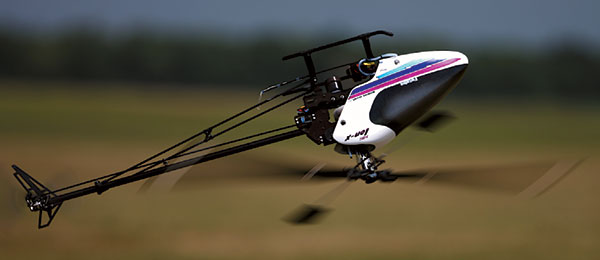
Written by Mark Fadely Radio Control Helicopters Column As seen in the July 2009 issue of Model Aviation.
Hi, everyone! Thanks for checking out this month’s column. We cover the coolest aspect of RC aviation. I am referring to helicopters. This is the place where we cover all things rotary. If you are new to the helicopter side of RC, you have an exciting world of discovery ahead. It takes a long time to gain enough knowledge and skill to control these machines. As experienced helicopter pilots know, there will be many roadblocks to becoming a successful flier. How would you define a successful pilot? Would it mean that he or she could fly a great 3-D routine? Or would you say a pilot who can merely hover is successful? I think a successful pilot is one who flies in a safe manner and can bring his or her helicopter back in one piece. A number of factory-sponsored pilots push their flights to the limit all the time. They pay for those daring flights with a number of crashes. When you get all your parts for free, the wrecks are not a big deal. For the average pilot, frequent accidents take the fun out of the hobby. Crashes are a part of all RC aviation. Minimizing them is usually the goal, but you must accept the fact that your pride and joy may not return in the same condition as when it last took to the air.
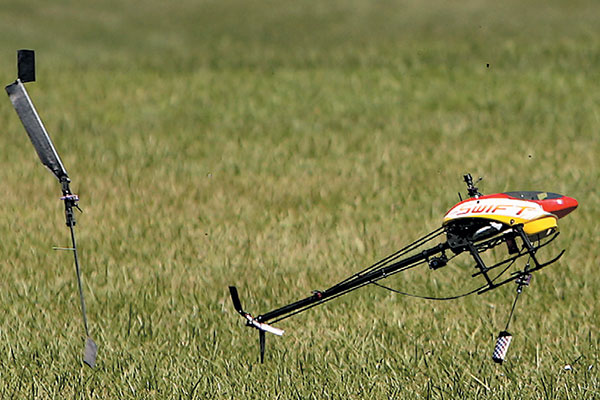
During a crash, sharp parts can fly in all directions. Always maintain a safe distance from the machine.
Wrecks damage our egos but, more important, they can severely injure people too. Personal-injury crashes are on the rise in the helicopter segment of RC. Statistically, our hobby is safer than ever, but there are more helicopters being flown than in past years. More helicopters equals more accidents. I ask everyone to take safety seriously. Most pilots are safe in their routines at the flying field. We need to help newer pilots understand the real dangers involved with our machines. Whether you are a new pilot or a seasoned flier, please help when you can to keep things safe. AMA member Jack Martin sent me a note of concern about safety. The flying season is in full swing, which means more helicopters will be in the air than at any other time of year. Jack is going to tell us a little about himself and share his experience as his club’s safety officer. “I am 56, a former dealership car mechanic, and later an EMT and paramedic in Las Vegas, Nevada. Now we live in Washougal, Washington, as we followed my wife’s career to Portland, Oregon, just across the river. I am now retired for medical reasons. “My wife of 22 years and I have two grown boys. My interest in aircraft started at age three. I built models as early as four years of age, then balsa and tissue rubber band power at 10. I struggled with RC at 23 and could barely afford a Sig Kadet airplane. “Back in those days, I would dream of how cool it could be to have RC helicopters or real turbine aircraft. It was really not even a dream back then. Now we have all these neat electronics. Back then a proportional radio was the big thing. “I left the hobby for several years for a career and to raise a family. I would drop in now and then, testing the helicopter waters in 1987, but I was never able to get the hang of it. I jumped back in with both feet in the year 2000, settling on scale aircraft in general, particularly scale helicopters. My careers have taught to me to think about what if such-and-such happens as a normal part of my everyday life.
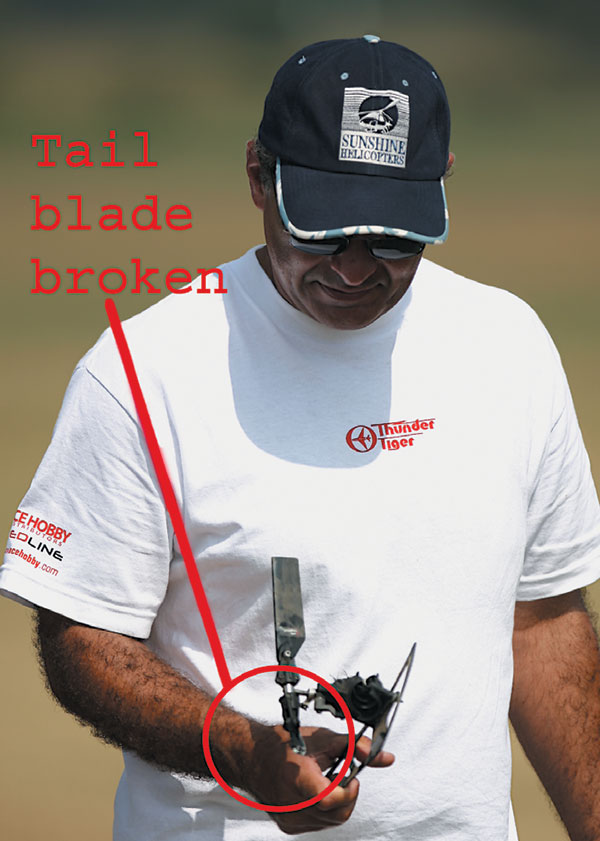
Stephen Bell inspects a postcrash tail assembly. A broken tail blade caused a loss of tail control.
“I am Safety Coordinator at my field, a CD, turbine CD, and I fly fixed-wing and rotary-wing aircraft. I hold a rotary turbine waiver. I have a very real concern about helicopter pilots in general. I prefer helicopters, so I am not picking on the ‘species’ so to speak. “In the last eight months, two people that I know have been severely injured/maimed by helicopters. In both instances the pilots fortunately had time to get at least one, if not both hands up to protect their heads. These could have been killers. One was a true accident, the other a mental lapse by the pilot. “I have noticed that helicopter pilots in general have a very dangerous tendency to be close to their helicopter while it is spooling/ spooled up. Things can happen so very fast with a helicopter. “As a group, RC pilots tend to not consider the possibilities of ‘what if?’ This, along with being too close to the aircraft, is a recipe for a severe injury. Those spinning things on the airplanes may be at a faster RPM, and are just as terribly dangerous, but other than starting and such, the spinning thing is way far away. This is not so with helicopter pilots. “I frequently have seen pilots spool up to ungodly speeds less than 10 feet from themselves. I had to speak to a gentleman at my field one day because I just could not watch him hover a .90-size helicopter with the blades only three feet away! The dude got mad at me when I confronted him!
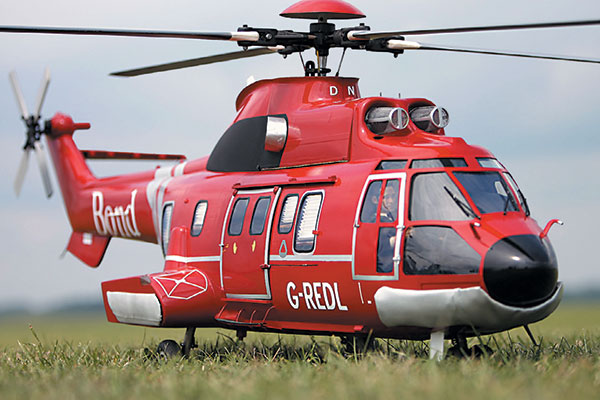
Large-scale helicopters such as this Puma can pack a lethal punch if the flight goes awry. Those rotor blades are more than 5 feet in diameter!
“A few weeks later he came back and thanked me because he had seen a failure when someone was doing the very same thing, only that time there was safe distance. It made him think. “So what is it we don’t consider? For one, servo failure is often forgotten about. Helicopters abuse servos. Scale flight is not as damaging as 3-D, but all helicopter flight is hard on servos. “Have you ever seen what can happen if a servo goes hard over due to a bad pot? I have had the misfortune twice. I never knew a helicopter could get upside down so fast. No one ever seems to consider the possibility of a servo failure. One of the instances was with a brand new servo and I don’t buy cheap servos either. “Can you imagine how severely the dude hovering three feet away would have been hurt if his aileron servo failed? It would have taken the top of his head off so fast, I shudder. I guess if you have to go, then that is a fast way! “Here is another scenario that happened to me: resonance. I was spooling up a large 1.8-meter turbine helicopter and it went into ground resonance and blew up on the ground. Blades blew by me at knee level. I got lucky. Some parts were as far away as 100 yards! I was 50 feet away from the helicopter. “Another friend was spooling up his helicopter, testing a setup. He was about 40 feet away, maybe less. A tail blade let go, he heard it whiz by his ear. It went through some ply siding on his garage. A 120-mm tail blade! “He always spools up with the tail not pointed directly at him. Good move, my friend. So, don’t spool directly inline with the tail either guys or gals. Blade grips can let go. This dude spooled up and took off at too high a head speed. His grips let go at about 20 feet up.
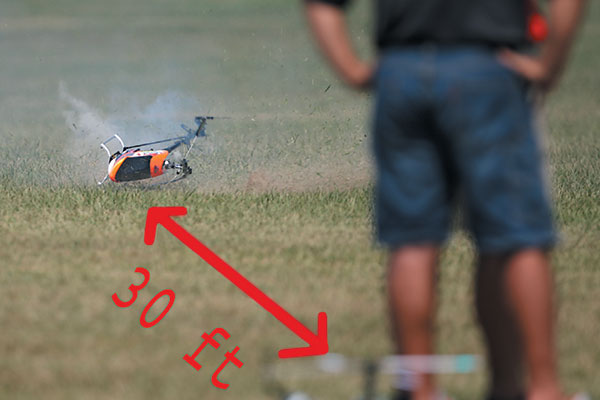
Although it is acceptable to fly within 25 feet of yourself, parts sometimes land more than 100 feet from the crash.
“I was 100 yards away and one blade went past me and landed on the grass, undamaged. The other blade was found two months later and it also was pristine, almost directly below where the mechanics went. “What was interesting, I watched the one blade as it made its traverse. It was spinning on its long axis giving it a ballistic effect, and made a sweet arc, burying the tip into the soft, wet sod about 20 feet back. I inspected the blades, he is still using them! “Another person I know is a very lucky you know what. He thought he could land a gasser on the stern of a boat traveling on the ocean. It was a small pleasure craft, and he was on the boat too. Well, things didn’t go as predicted and the helicopter came into him. There was no room for error, no room for escape, and no thought to the possibility of ‘what if?’ “This type of incident can give the whole hobby a bad name and we need to think about that. Even if it is not at a sanctioned field or event, what we do can have a serious effect on the entire hobby. He was able to use his hands six months later, [after] several surgeries, loss of work, and so on. He does still fly, but never close to himself any more. “We helicopter pilots, as a group, need to be more aware of the dangers we face, consider them, and incorporate them into greater safety margins on the ground. I don’t want any more of my friends to show me how they saved their lives with their hands. “These incidents are going to happen. When they happen is a big if. Therefore, the only common sense approach is to start looking out for the ‘what if’ scenario so we can prevent it or decrease the severity of it.
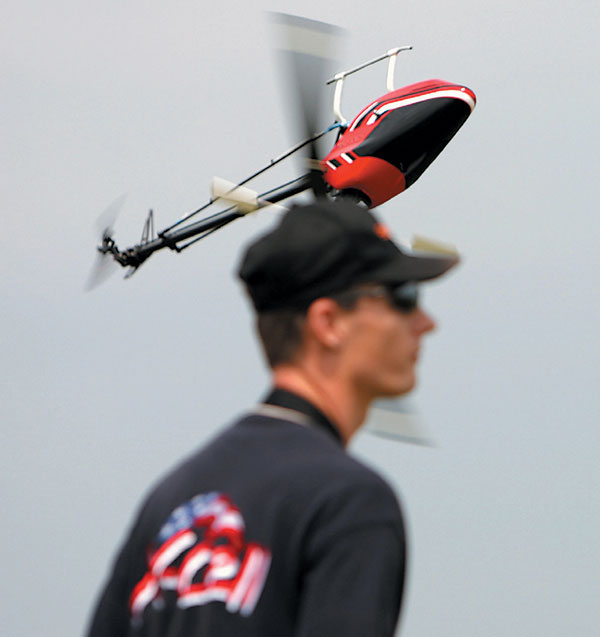
This dangerous situation occurred during a tandem demonstration flight. The helicopter was too close and is going toward the other pilot’s blind side.
“All of these lucky instances were the result of adequate distance from the helicopter. They happened to competent pilots. I hear these types of stories all the time. “Pooh happens folks; prepare for it. Give yourself some distance. Save yourself from maiming. Physical therapy is costly, being in the hospital is costly, and losing income is costly. Injuring your ego—priceless!” Thanks for the provocative stories and information, Jack. You have been on the front lines as a paramedic, seeing things that most of us are not exposed to. I find it interesting to hear from people who work in the medical community. You have a different outlook on life and you know that accidents do happen. Thanks to you for reading what Jack wrote. Safety is not something we want to think much about, because it seems to take some of the fun out of our flying. We all need to be responsible pilots and not lose sight of safe flying practices. -Mark Fadely










Add new comment